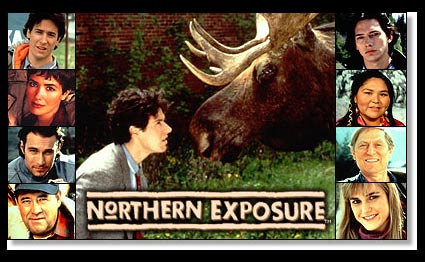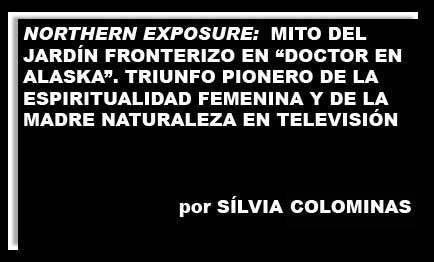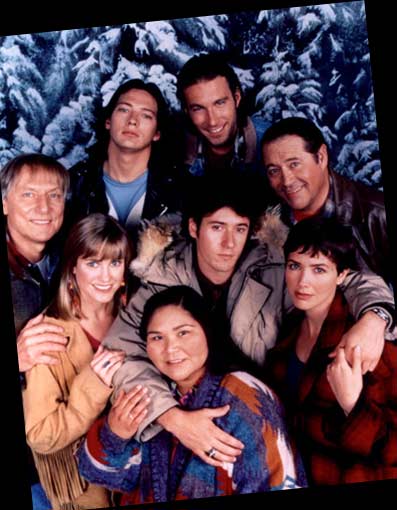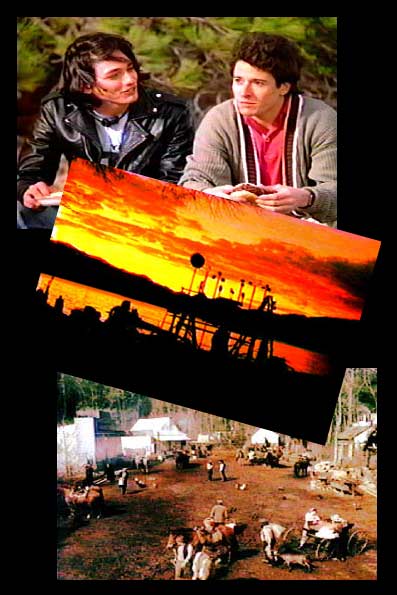

Northern Exposure. Contexto histórico televisivo
En U.S.A. la televisión se convirtió en un fenómeno social en los 50, pero las señales hertzianas que transmitían la información de las emisoras de televisión americanas del momento 1 (ABC, CBS, NBC y, más tarde, la FOX 2) no llegaban a todas partes. Como solución en las zonas rurales nacieron las CATV (Community Antenna TV), es decir, la televisión por cable que recogía la señal hertziana y la redistribuía por un sistema de cable. Al principio sin ánimo de lucro pero después las tiendas de electrodomésticos establecieron una cuota mensual por su distribución instituyéndose como empresas privadas que cobraban por un servicio.
Inicialmente la televisión por cable convivió pacíficamente con las Networks porque se consideraba una alternativa pasiva por la mala recepción de la señal hertziana, pero después se estableció una competencia importante y la FCC (Federal Communication Comission) tuvo que regularizar el panorama audiovisual. En 1966 frenó el crecimiento del cable al determinar que sólo era una alternativa auxiliar a las Networks, pero en 1974 rectificó por la presión de los inversores del cable y la reconoció como alternativa sólida e independiente. En el sistema televisivo siempre priman los intereses económicos sobre las funciones sociales del medio; “In the American system of broadcasting, the first step was not a convinction about the effort programming should make to serve the country(...). The decisions are made based on what reaps the profit 3”.
La evolución tecnológica creó una nueva forma de entender y hacer televisión - “Television has grown and changed because of technological innovation (…) it´s a creature of technology 4”- no sólo a nivel de infraestructura sino también a nivel formal y de contenido. Según Thornton Caldwell la tecnología y el contexto definían cada estilo televisivo; – “By the mid-1970´s, “guerrilla video” and “alternative television” provided “progressive” working models for production (…) around 1980, the dominant media began to announce ownership of the very tactics of radicality once thought to be defining properties of the avant-garde. (...) the reemergence of an activist small-format camcorder revolution at the end of the Reagan-Bush-Gates era in the early 1990´s 5 ”.

En los 90 el panorama televisivo en USA era altamente competitivo. El fin del monopolio y la fragmentación de la audiencia causada por la especialización de la oferta hizo que las políticas de programación de las Networks cambiasen y se esforzasen en hacer más atractiva su oferta para competir con la tematización que ofrecía la televisión por cable “ the networks are acting more and more like cable webs all the time, meaning they show a greater propensity to target specific audience groups 6”. La televisión en los 90 estaba inmersa en el Culto a la Diversidad que menciona Thornton Caldwell 7. La tematización de los canales fragmentaba la audiencia; un canal para cada interés, grupo cultural, etc. La audiencia ya no era una masa homogénea sino individuos independientes con sus necesidades, intereses, religión, raza, etc; “Cable, its pay options, and satellites were to create multiple, parallel but distinctive audiences attending at the same time to such specialized topics as finance, health, the arts 8”.
Aún siendo cadenas generalistas, las Networks decidieron diferenciarse en la ficción que producían y emitían, el público al que se dirigían y los valores que ensalzaban. En los 80, la ABC obtó por ser la televisión de y para las mujeres 9 emitiendo series como China Beach, Thirtysomething o Moonlighting 10. La NBC obtó por una línea intelectual y urbana con L.A Law o Law and Order. Como afirma Aisner citando a Sagansky, Vice-Presidente de programación de la NBC entre 1982 y 1989, “The key is finding the right niche (...). At NBC that meant developing smart, urban shows (...) 11 ”.
2. La CBS y Northern Exposure
El cable estableció el Culto a la Diversidad que no dejó indiferente a las Networks, ni siquiera a la CBS; “Waves from cable´s new cult of diversity swept back to the aging networks as well. Even venerable CBS fantasized in 1993 that it was niche programming 12”. Según Sagansky, Presidente de Programación de la CBS desde 1990 a 1994, la clave era encontrar el target adecuado al que dirigirse. Mayoritariamente las políticas de programación discriminaban a sus espectadores por cuestiones de género pero este criterio no siempre era suficiente; “Broad divisions for gender would soon not be enough 13”.
Northern Exposure (“Doctor en Alaska”, en España) es una serie que apareció en la televisión norteamericana el 12 de julio de 1990 en la CBS (jueves. 22:00 14)- tras el éxito de David Lynch, Twin Peaks que se había emitido en la ABC 15 los sábados en prime time y siempre se ha considerado su referente más directo 16.
Tras el éxito veraniego de su primera temporada, esta serie de Brand & Falsey se emitió en abril después de Murphy Brown y Designing Women y se mantuvo en Prime Time los lunes en la CBS durante 5 años 17 . La programación de la CBS en los 90 fue variada y encontramos series tan dispares como Family Man, Evening Shade, Dallas, incluso Picket Fences 18 de E.Kelley 19 a partir de 1992, serie que se consideró heredera de Northern Exposure . Ante esta disparidad es difícil establecer el niche de mercado de la CBS y cómo la “peculiar” Northern Exposure se ajustaba a él. Peculiar porque Northern Exposure creaba en el espectador una actividad mental más allá de la mera diversión, algo inusual según el estudio de W.Russell Neuman (1982), sociólogo del Instituto de Tecnología de Massachussetts; “In sum, cognitive activity while viewing apparently is not very great and for a sizable number of viewers it is nul 20”.
DuBrow, citando a Sagansky, afirma que “No1. CBS Has Its Eyes on Middle-Age Viewers 21 ” . Sagansky afirma que realmente la CBS no hacía niche programming 22 sino que programaba para una amplia audiencia femenina; “I was programming for not a niche, but a very large audience indeed. Women. Women who were confident in their abilities. Their abilities at raising families, having satisfying relationships and performing in the workplace. The successful shows on CBS included Murphy Brown, Picket Fences, Dr. Quinn, (...), Northern Exposure. They all featured strong women 23”. Yendo más allá, en nuestra opinión, durante los 90 la CBS no buscaba tanto un target regido por cuestión de género sino una programación rica en unos valores concretos. No en vano, en Northern Exposure hay una variada polifonía multicultural que habla, como reflexiona Williams, “to many groups somewhat marginalized by much of network fare, such as Native Americans 24 ”. También a los gays, lesbianas e, incluso, a la gente mayor porque encontramos personajes principales cercanos a la tercera edad -Ruth Anne (Peg Phillips 25), Holling (John Cullum), Maurice (Barry Corbin), Walter (Maultrie Pattern), etc.

Northern Exposure deja el típico núcleo familiar de otras series y se establece en el núcleo familiar de una rústica ciudad, Cicely. En pocas palabras Northern Exposure es, como dice Tortorici 26 , sucesor de Sagansky “ the type of show that gives people not predisposed to television a reason to watch 27 ." Para analizar la programación de la CBS en los 90, Williams explica la estrecha relación que la CBS tuvo ya en los 70 con la MTM Enterprises Inc emitiendo sus series 28 . De hecho, los creadores oficiales 29 de Northern Exposure , Brand y Falsey, pertenecieron a la MTM y a principios de 1992, la CBS compró producciones televisivas facilitadas por ésta 30. Brower destaca que “Feuer observes that the MTM company was one of the first program suppliers (...) to cultivate a house style and a coherent image 31” y, según Williams, Schatz establece que las series de la MTM marcaron un estilo caracterizado por “an ensemble cast, domesticated workplace, multiple plots in a semi-serial format, aggressive cinematic technique and “quality” viewer demographics 32 ”. Northern Exposure presenta todos estos rasgos propios de la llamada televisión de calidad, término resbaladizo y subjetivo donde los haya pero que Feuer delimita explicando “Quality Tv refers to those programs produced at an independent house (...) maintain fairly consistent demographic profile and display an authorial style evinced at the textual level by two key characteristics:self-reflexivity and liberal humanism 33 ”.
Al principio Brand y Falsey por encargo de la CBS y el acuerdo con Universal, idearon Northern Exposure como una serie de ocho episodios 34 ; “ They were able to give me a good price on the show, thanks to a deal with P&G, and I liked the material enough to order 6 episodes 35 ”. Pero, debido al triunfo inesperado, la CBS amplió su tiempo de emisión repitiendo la fórmula con otra temporada. "Jeff (Sagansky) said to us, 'What you did on the first eight shows? Just do it again 36 ”. Es “La temporada de los cambios veraniegos (...) es la época de prueba de nuevas emisiones (...) se conoce en el negocio como la (…) bombout season 37 ”.
El estilo pionero de Northern Exposure ejemplifica una apuesta muy concreta por la fantasía y la imaginación; “ As Turner says: "I think we all yearn for this. We're all becoming very metropolitan and franchised and Alaska symbolizes something that has kept its individuality 38 ". También por la interactividad porque es una serie con diferentes niveles de lectura que invita al espectador a conjeturar. Northern Exposure permite pensar, da un amplio margen al intelecto; “ We always say that we wanted to create Alaska as a state of mind, a place where people could re-create themselves in a nonjudgmental universe 39”. No es casual que esta serie tan multicultural aparezca durante el Culto a la Diversidad y al multiculturismo tornándose una metáfora del Forum Cultural que debiera ser la televisión según Newcomb y Hirsch “ (...) the idea of the “forum” is more than a metaphor in its own right. In forming special interest groups, or in using such groups to speak about television, citizens actually enter the forum. Television shoves them toward action, toward expression of ideas and values (...). Bringing values and attitudes (...) to the texts, the viewers selects, examines, acknowledges and makes texts of his or her own 40”. Aunque no nos equivoquemos, el multiculturalismo televisivo es fruto de unas necesidades mercantiles y no de una ideología verdaderamente respetuosa con la diversidad cultural; “(...) television networks, following the directives of “niche-marketing”, increasingly divide their audiences in terms of gender, class, race, or age, (...) exhibiting a multiculturalism not by political correctness but by market imperatives 41”. No en vano, el estudio de Gitlin, sociólogo de la Universidad de California, contemplado en la obra de Comstock, afirma; “So the networks (…) are not trying to stimulate us to thought, or inspire us to belief, or remind us of what is to be human and live on the earth late in the twentieth century; what they are trying to do is to “hook” us 42 ”. Más adelante, contemplando a Les Brown, sostiene que “television only appears to be in the business of entertainment, sports and news. In fact, it is in the business of vending the attention of the public to parties interested in selling their products to that public 43 ”.
La apuesta por Northern Exposure , heredera de Hill Street Blues, L.A.Law, St. Elsewhere –también creación de Brand y Falsey-, salió redonda y se alargó hasta cumplir seis temporadas, 110 episodios. Finalmente dejó de emitirse el 26 julio de 1995 porque ya no era lo que había sido; “I didn't cancel NE, my successor Peter did. With Joel gone and the original writers gone Peter made the right decision. The air had gone out of the balloon 44 ”. A pesar de todo hoy en día Northern Exposure se repone con éxito en cadenas de pago via satélite 45 y los fans mantienen vivo su espíritu y luchan por su edición en DVD, sueño en parte realizado en el 2004.

